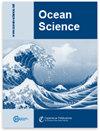A simple diagnostic based on sea surface height with an application to central Pacific ENSO
IF 3.3
3区 地球科学
Q2 METEOROLOGY & ATMOSPHERIC SCIENCES
引用次数: 0
Abstract
Abstract. We use output from a freely running NEMO model simulation for the equatorial Pacific to investigate the utility of linearly removing the local influence of vertical displacements of the thermocline from variations in sea surface height. We show that the resulting time series of residual sea surface height, denoted ηnlti, measures variations in near-surface heat content that are independent of the local vertical displacement of the thermocline and can arise from horizontal advection, surface heat flux, and diapycnal mixing processes. We find that the variance of ηnlti and its correlation with sea surface temperature are focused on the Niño4 region. Furthermore, ηnlti averaged over the Niño4 region is highly correlated with indices of central Pacific El Niño–Southern Oscillation (CP ENSO), and its variance in 21-year running windows shows a strong upward trend over the past 50 years, corresponding to the emergence of CP ENSO following the 1976/77 climate shift. We show that ηnlti can be estimated from observations, using satellite altimeter data and a linear multi-mode model. The time series of ηnlti, especially when estimated using the linear model, show pronounced westward propagation in the western equatorial Pacific, arguing for an important role for zonal advective feedback in the dynamics of CP ENSO, in particular for cold events. We also present evidence that the role of the thermocline displacement in influencing sea surface height increased strongly after 2000 in the eastern part of the Niño4 region, at a time when CP ENSO was particularly active. Finally, the diagnostic is easy to compute and can be easily applied to mooring data or coupled climate models.基于海面高度的简单诊断及其对中太平洋ENSO的应用
摘要我们使用赤道太平洋自由运行的NEMO模型模拟的输出来研究线性消除海洋表面高度变化对温跃层垂直位移的局部影响的效用。结果表明,所得的剩余海面高度(ηnlti)时间序列测量了与温跃层局部垂直位移无关的近地表热含量的变化,这些变化可能由水平平流、地表热通量和底流混合过程引起。结果表明,ηnlti的变化及其与海温的相关性主要集中在Niño4区域。此外,Niño4地区的平均ηnlti与中太平洋El Niño-Southern涛动(CP ENSO)指数高度相关,其21年运行窗口的方差在过去50年中呈现出强烈的上升趋势,与1976/77年气候变化后CP ENSO的出现相对应。利用卫星高度计数据和线性多模态模型,我们可以从观测中估计出ηnlti。ηnlti的时间序列,特别是使用线性模式估计时,显示出赤道西太平洋明显的向西传播,表明纬向平流反馈在CP ENSO动力学中起重要作用,特别是在寒冷事件中。我们还提供证据表明,2000年以后,在Niño4区域东部,当CP ENSO特别活跃时,温跃层位移对海面高度的影响作用增强。最后,该诊断方法易于计算,可方便地应用于系泊数据或耦合气候模型。
本文章由计算机程序翻译,如有差异,请以英文原文为准。
求助全文
约1分钟内获得全文
求助全文
来源期刊

Ocean Science
地学-海洋学
CiteScore
5.90
自引率
6.20%
发文量
78
审稿时长
6-12 weeks
期刊介绍:
Ocean Science (OS) is a not-for-profit international open-access scientific journal dedicated to the publication and discussion of research articles, short communications, and review papers on all aspects of ocean science: experimental, theoretical, and laboratory. The primary objective is to publish a very high-quality scientific journal with free Internet-based access for researchers and other interested people throughout the world.
Electronic submission of articles is used to keep publication costs to a minimum. The costs will be covered by a moderate per-page charge paid by the authors. The peer-review process also makes use of the Internet. It includes an 8-week online discussion period with the original submitted manuscript and all comments. If accepted, the final revised paper will be published online.
Ocean Science covers the following fields: ocean physics (i.e. ocean structure, circulation, tides, and internal waves); ocean chemistry; biological oceanography; air–sea interactions; ocean models – physical, chemical, biological, and biochemical; coastal and shelf edge processes; paleooceanography.
 求助内容:
求助内容: 应助结果提醒方式:
应助结果提醒方式:


